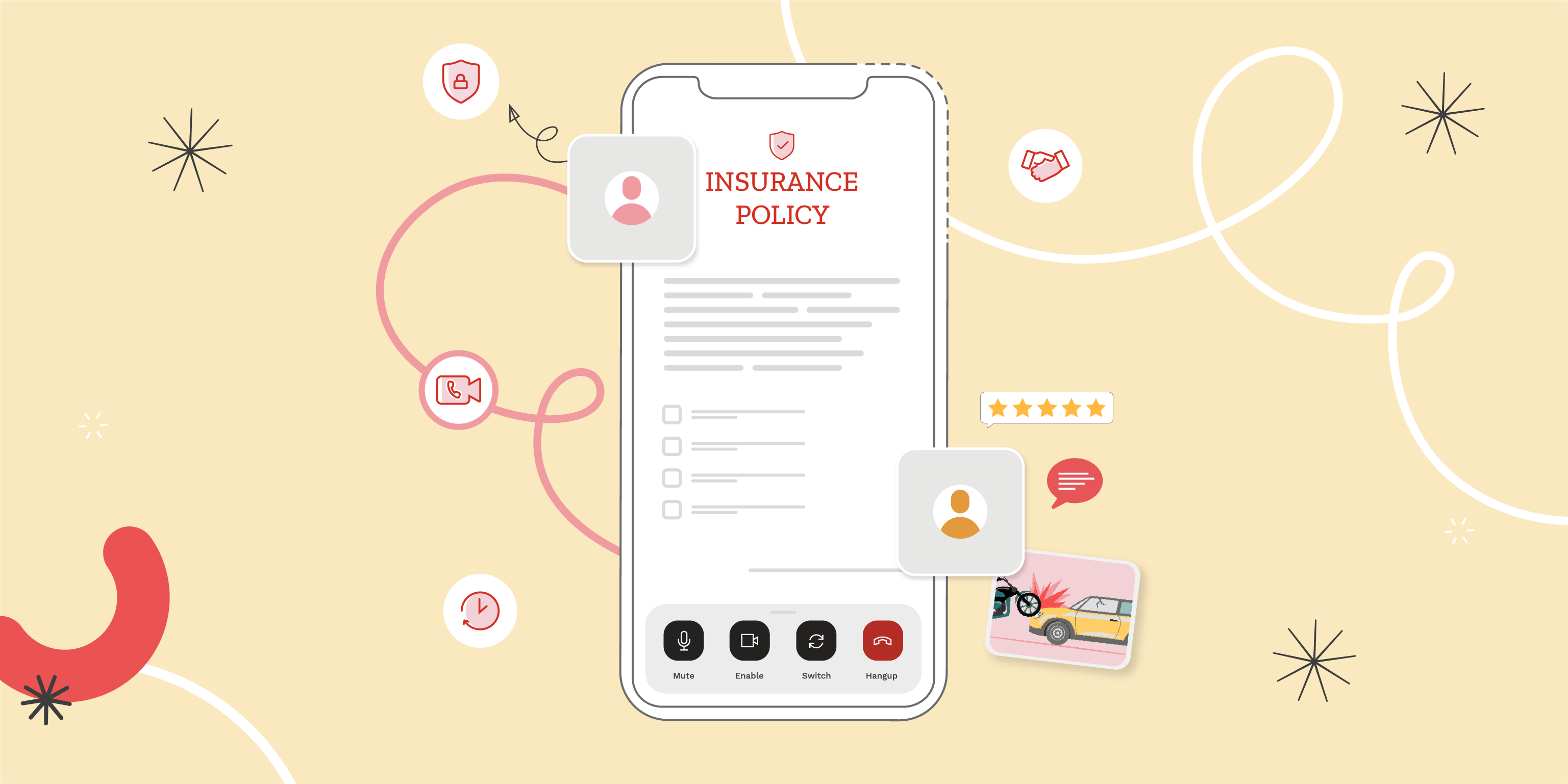In an era driven by the pursuit of convenience and operational efficiency, the insurance sector has wholeheartedly embraced innovative technologies to elevate customer experiences. One such technology that has revolutionized the industry is video chat. By enabling real-time, face-to-face interactions between insurance agents and customers, video chat has brought forth a multitude of benefits that are transforming the way insurance services are delivered.
In this blog, we will explore seven key advantages of video chat for the insurance sector, highlighting how this technology is reshaping customer engagement, operational efficiency, and overall satisfaction.
1. Improved Customer Experience
With the option of video chat, insurance agents can now provide a level of personalized service that surpasses traditional communication methods. By seeing and speaking with their customers through a video chat, agents can fully understand their needs and provide tailored advice and recommendations.
For instance, if a customer has a question about a particular type of insurance, an agent can use a video chat to walk them through the policy, clearly explaining the benefits and coverage options in a personalized manner. This approach to communication is not only more convenient for customers, but it also allows for a more personalized touch that can improve their overall experience. Customer satisfaction levels can be significantly higher when they feel valued and seen as individuals.
2. Enhanced Trust and Transparency
By enabling face-to-face communication between customers and insurance agents regardless of their location, video chat brings an added level of human connection and interaction to the insurance industry.
Seeing a person on the other end of the video chat can help to build trust and credibility with customers. For example, when an insurance agent gives a diagnosis, recommendation, or explanation of a coverage policy, seeing their face and body language can help to convince the customer that they are trustworthy and credible.
Video chat can also create a more transparent relationship between the two sides, as it provides an opportunity for customers to ask any questions and get detailed explanations in real-time, leading to a more informed decision-making process. With the aid of video chat, insurance companies can leverage this technology to provide superior customer service and enhance their credibility with customers, resulting in a more transparent insurance sector.
3. Increased Efficiency
Using video chat and conferencing capabilities, clients can easily and conveniently connect with their insurers, eliminating the need for face-to-face meetings. For example, insurance claims adjusters can conduct virtual inspections of damaged properties, reducing time spent on the road and improving the speed of the claims process.
Agents can also help customers complete policy applications in real-time, saving both parties valuable time and increasing the speed of policy issuance.
4. Cost Savings
In the highly competitive insurance sector, cost savings can make a considerable difference to the bottom line. Using video chat technology, insurers can capitalize on a highly efficient communication tool that saves money on various expenses, including travel, lodgings, and other related costs associated with face-to-face meetings.
Video chat brings significant cost savings to the insurance sector through various means:
Claims Processing: Video chat allows insurance companies to conduct virtual inspections for claims processing, particularly for property and vehicle claims. Instead of sending an adjuster to physically assess the damage, policyholders can use video chat to provide real-time footage or images of the affected property or vehicle. This eliminates the need for travel expenses, saving the insurer’s costs associated with sending adjusters to different locations.
Virtual Assessments and Underwriting: Insurance underwriters often need to assess risks associated with insuring properties or vehicles. Video chat enables underwriters to conduct virtual inspections, eliminating the need for on-site visits. By leveraging video chat, underwriters can evaluate risks remotely, saving time and travel expenses. This efficiency translates into cost savings for insurance companies.
Remote Customer Service: Insurance companies can offer virtual customer service through video chat. This allows customers to receive assistance with policy inquiries, claims filing, or general support without needing to visit a physical office. By replacing in-person meetings with video chat interactions, insurance companies can reduce costs related to maintaining multiple branch locations, staffing, and infrastructure.
Agent Training and Collaboration: Instead of organizing in-person training sessions or meetings, video chat enables insurance agencies to conduct remote training programs for their agents. This eliminates travel expenses for trainers and agents and reduces the need for dedicated training facilities.
Remote Sales and Consultations: Agents can showcase policy options, explain coverage details, and answer customer questions via video chat, eliminating the need for in-person sales meetings. This saves costs associated with travel, accommodation, and time spent commuting to meet clients.
Improved Efficiency and Time Savings: Video chat enhances overall operational efficiency by reducing the time spent on administrative tasks and improving communication between stakeholders. Quick video conferences and virtual meetings enable faster decision-making and collaboration, ultimately saving time and increasing productivity for insurance companies.
5. Better Customer Engagement
The insurance industry relies heavily on building deep and long-lasting customer relationships. Video chat has emerged as an exceptional tool for the insurance sector, enabling a more immersive customer experience and better communication between the customer and agent.
By providing face-to-face interaction and the ability of customers to see and hear their insurance agents in real-time, video chat can help combat the drawbacks of traditional email communication that often lead to a lack of personalization and trust.
For instance, customers can showcase their policies on video and ask any questions they have about them, generating more engagement. Additionally, claims can be processed faster and more efficiently as customers can share visuals of damage caused, allowing the agent to suggest effective solutions.
Overall, video chat can lead to better engagement and build stronger customer relationships, setting the insurance sector up for success.
6. Higher Conversion Rates
The traditional approaches to insurance sales are becoming obsolete as customers seek more convenience and customized services. Video chat sessions can help agents explain complex policies, clarify doubts and answer questions in real-time, which can create added confidence for the customer in the Company and ultimately enhance the likelihood of conversion.
For instance, a potential customer can meet with an agent online and get a tour of the digital service capabilities offered. The video meeting will enable the potential customer to get a first impression of the company’s culture, which, if positive, will lead to more significant customer retention and more positive reviews.
By delivering an exceptional customer experience, video chat can help insurers improve conversion rates and increase their revenue.
7. Integration with Other Insurance Software
One of the major advantages of integrating video chat with other insurance software, such as customer relationship management (CRM) systems, is the ability to streamline the entire process from start to finish. Agents can easily connect with customers across multiple platforms, including mobile devices and desktop computers.
This integration also offers a more personalized approach to insurance, as customers can now see and interact with their agents face-to-face, thereby building trust and establishing a stronger rapport.
By integrating video chat with other insurance software, insurance companies can provide a best-in-class service to their customers, while improving agent productivity and reducing the overall cost of providing customer service.
In Summary
From reducing paperwork and allowing for quicker claims processing to improving customer experience, the benefits of video chat in the insurance sector truly cannot be overstated. This powerful technology is already revolutionizing the way insurance companies are doing business and is likely to become even more important in the coming years.
Through further development of AI and advanced security measures, using video chat in the insurance field is steadily becoming a safe, beneficial option for all involved. Insurance companies should take advantage of this innovation as soon as possible to stay ahead of their competition while ensuring their customers get the highest quality service. With all its advantages, video chat is sure to be an indispensable asset to the entire insurance sector.

Harish Thyagarajan
Content Marketer
Supercharge Your Communication!
Get in touch with our experts who strive hard to bring the very best in cloud communications technology to you.


